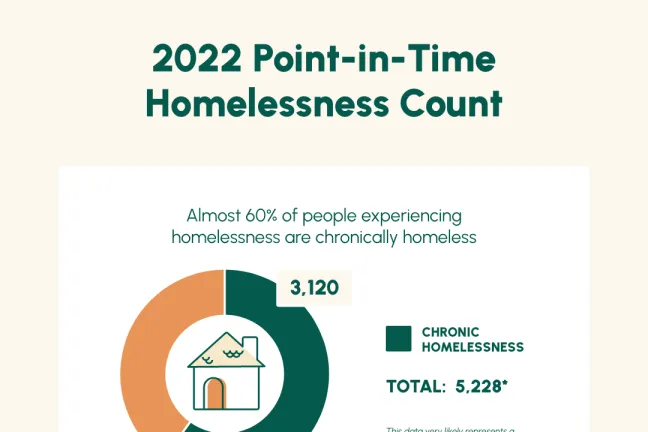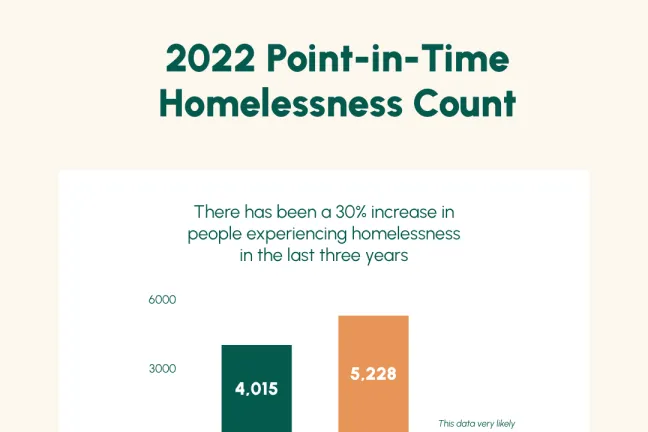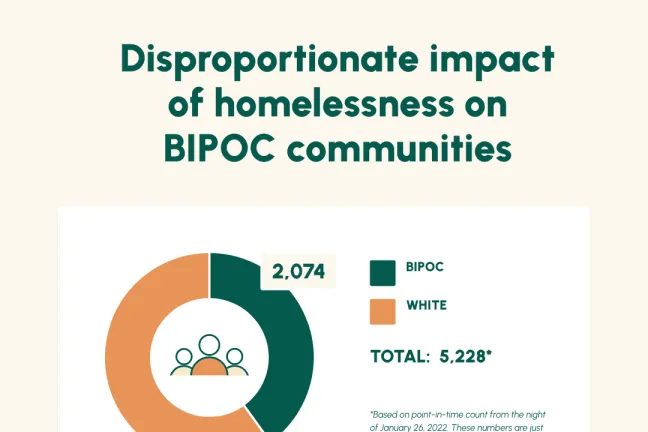For immediate release: Wednesday, May 4, 2022
Contact:
Denis Theriault, Joint Office of Homeless Services, denis.theriault@multco.us
Emily Roots, Washington County, Emily_Roots@co.washington.or.us
Dylan Blaylock, Clackamas County, dblaylock@clackamas.us
NEWS RELEASE: Tri-county Point in Time Count numbers, shared regionally for first time, show shifts in homelessness
PORTLAND — Leaders from the three Portland-area Metro counties on Wednesday, May 4, for the first time jointly released numbers from their federally required counts of people experiencing homelessness.
In the first full regional snapshot of homelessness since the start of the COVID-19 pandemic, 6,633 people were counted as experiencing homelessness on the night of Jan. 26, 2022.
Of those 6,633 people counted, 3,611 were experiencing unsheltered homelessness. An additional 2,222 people were counted in shelters, with 800 more in transitional housing.
- Multnomah County:
- 5,228 people (3,057 unsheltered, 1,485 in shelter, 686 in transitional housing)
- Washington County:
- 808 people (227 unsheltered, 496 in shelter, 85 in transitional housing)
- Clackamas County:
- 597 people (327 unsheltered, 241 in shelter, 29 in transitional housing)
The results, which will be reported to the U.S. Department of Housing and Urban Development, also make clear that people of color continue to face disproportionate rates of homelessness. In Multnomah County, for example, people of color made up almost 40 percent of everyone counted this year.
Data limitations: Point in Time Count tells only a partial story
This year’s data, like with every Point in Time Count, should be considered an undercount of people experiencing homelessness.
Because of federal rules, the Count does not include thousands of people who did not have a home of their own on the night of Jan. 26 but were “doubled up,” staying with friends or family. Culturally specific providers tell us that people of color are more likely to experience homelessness this way and are underrepresented in the Count as a result.
It’s also not possible to definitively find, survey and count every person experiencing homelessness.
The outcome of the Count does not directly affect funding levels, but conducting the tally helps ensure our communities remain eligible for federal funding for housing and homelessness services. (Those funds are separate from federal COVID-19 funding.)
As a one-night snapshot, the federally structured Count also isn’t designed to reveal how many people move in and out of homelessness over the course of a year, either losing their housing or gaining it back with support services.
The extent of homelessness in the community isn’t static, and the number of people experiencing homelessness who need services over the course of a year is much larger than any one-night number.
Pandemic and expensive housing market present ongoing challenges
The results this year speak to the ongoing effects of the COVID-19 pandemic. The pandemic continues to present serious challenges for vulnerable community members – sharply affecting service providers and leaving unsheltered homelessness far more visible in the tri-county region.
And just as they did before the pandemic, people living with fixed incomes and/or disabling conditions also continue to bear the brunt of the region’s housing crisis. In fact, even during the pandemic, rents and home prices in the Portland-area have continued to grow at one the nation’s fastest paces.
A recent survey by Redfin, as reported by local media, found that rents for Portland residents have climbed roughly 40 percent since March 2021.
The region also continues to see significant numbers of people counted as experiencing chronic homelessness. That means they have at least one disabling condition — a mental health condition, addiction disorder, chronic illness or physical disability — and have been homeless for at least a year.
Overall, the three counties tallied 3,674 people who met that definition.
Chronic homelessness is the primary focus of extensive new regional funding, through the voter-approved Supportive Housing Services Measure, that finally became available for programs in July 2021, mere months before the Count.
Since then, the three Metro-area counties have been investing those funds, along with other new local, state, and federal resources, into hundreds of additional shelter beds, street outreach teams, and supportive housing placements. Metro, the regional government that distributes the funds, has posted a dashboard showing that growing impact.
Local governments have also invested substantial federal relief funds into rent assistance programs to prevent what could have been a tidal wave of new homelessness, while also using federal funds to increase shelter and hygiene services, through programs like the Safe Rest Villages and others.
Multnomah County: Years of strengthened data reporting helps overcome COVID limitations
The Joint Office of Homeless Services was originally scheduled to conduct a Point in Time Count in January 2021, which would have been its first since 2019. But because of the COVID-19 pandemic – in the months before vaccines would become widespread – it joined agencies nationwide in seeking federal permission to postpone for a year.
And, just as the Joint Office warned in January, the pandemic’s impact on the Count remained significant – coming at the height of Oregon’s record-smashing Omicron surge.
Despite signups from dozens of volunteers, COVID-19 cases and restrictions severely hampered the work of outreach teams and daytime service centers that historically contributed hundreds of surveys to the Street Count.
Teams were unexpectedly forced to quarantine or were faced with lost staff the week of the Count, among other factors, the number of surveys returned was lower than expected.
In consultation with the U.S. Department of Housing and Urban Development, the Joint Office devised a supplemental strategy that drew from its dedicated work in recent years expanding its capacity for data collection.
Using data from Multnomah County’s three by-name “Coordinated Entry” services access lists, the Joint Office was able to identify hundreds of additional people who were likely experiencing unsheltered homelessness on the night of the Count. That kind of supplemental data was not available at the same scale in past counts.
The Joint Office will issue its traditional full report later this summer – expanding significantly on the snapshot numbers released Wednesday, with deeper dives into the subjects that will better help the Joint Office inform policy: Demographics, COVID-19 impacts, and other factors.
The Joint Office is planning another Point in Time Count in January 2023, next year, returning to its typical schedule of conducting counts in odd-numbered years.
Overall, in next year’s budget, the Joint Office is requesting funds to support more than 2,000 shelter beds. Including COVID-related shelters and federal funding for Safe Rest Villages, that number would grow to nearly 2,700, almost double what was available before the pandemic.
“I believe in both/and responses to homelessness. That’s why I’ve led work to add hundreds of shelter beds, from villages to motels, before and during this pandemic. It’s also why I championed our Behavioral Health Resource Center, opening downtown later this year,” Chair Deborah Kafoury said. “But I’ve also worked to ensure we don’t give up on work that will help people leave those shelter beds, or avoid them in the first place: housing with support services. With rent assistance and the right amount of support in place – from case management to treatment – anyone can thrive in housing.”
Washington County: Unsheltered homelessness decreases from 2021 thanks to increased shelter options across Washington County
Washington County was able to complete a Point in Time Count in 2021 through partnerships with service and outreach providers.
Washington County saw an increase in homelessness from 716 people in 2021 to 808 people in 2022 due to a variety of factors, including the ongoing impact of the pandemic. But unsheltered homelessness also dropped significantly.
This is due to increased access and availability of shelter options in Washington County with new bridge shelter locations and new and extended winter shelter options. There were 269 people in shelter in 2021 and 496 people sheltered during Washington County’s annual count, according to 2022 Point in Time Count results.
Washington County Chair Kathryn Harrington shares, “Our response solutions have increased, yet there is much more to do. Homelessness should never be necessary in our region. We have seen the impact from increasing shelter options and expanded housing resources to support our most vulnerable community members.”
Clackamas County: Limited data collection still provides insights for future investments
Clackamas County’s Point in Time Count, along with the counts of Multnomah and Washington counties, was affected by the significant increase of COVID-19 cases as the Omicron variant surged throughout Oregon.
While dozens of county staff and volunteers mobilized for the Count, COVID-19 outbreaks and the implementation of necessary safety measures amongst outreach teams and at collection sites limited the breadth and scale of data collection normally conducted during Point in Time Counts.
Even with these limitations, the collected data will provide valuable insights into the current scale of the housing crisis in our region and where efforts to address it should be prioritized. The county is pursuing additional investments in a plethora of service areas, including emergency and transitional shelters, outreach and engagement, and supportive housing services.
In April, the county published a document outlining its values on housing and shelter which helps guide the county’s priorities in addressing the housing crisis our region is currently experiencing. These 13 values guide the county’s work in establishing lasting and effective programs and services, designing equitable housing access and solutions, and incorporating robust community engagement. As analysis of the Point in Time Count results continue, the county will identify additional services and programs for expanded investments which will continue to embody these values and have the most significant effect in assisting our neighbors currently experiencing homelessness.
“Clackamas County aims to make homelessness and housing instability rare, short, and not recurring,” stated Clackamas County Chair Tootie Smith. “Our supportive housing services team is making excellent progress toward its first year goals to provide outreach, case management and permanent housing for those in need. This work, coupled with the Board of County Commissioners’ goal to develop 1,500 affordable housing units, puts the county on track to make a significant difference for all members of our community.”
###



